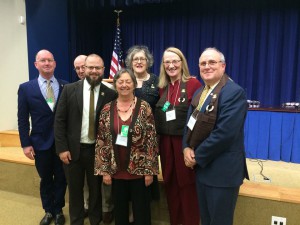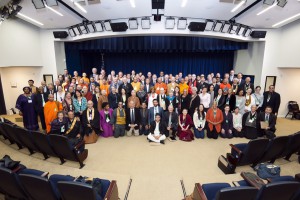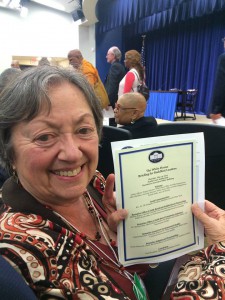Sunday
Featured StoriesShambhala Visits the White House

The Shambhala Delegation to the Buddhist Leaders Conference and White House Briefing in the Briefing Auditorium at the WH
by Acharya Judith Simmer-Brown
photos by Acharya Marty Janowitz
A Shambhala delegation attended the historic Buddhist Leaders’ Summit at the White House on Thursday, May 14th. One hundred twenty-five leaders and teachers from sixty-three different Buddhist communities and organizations were invited to present the Buddhist Climate Change and Racial Justice Statements to senior advisors of President Obama’s in a first-ever Buddhist lobbying group. In attendance from Shambhala were Acharyas Janowitz, Lobel, and Simmer-Brown; Naropa Environmental Studies professor Sherry Ellms; GreenFaith Board member Irene Woodard; New York Shambhala Center Director Timothy Quigley; and President Emeritus Richard Reoch.
The Summit was the first organized intersangha Buddhist lobbying group to visit the White House, representing an historic moment in the development of American Buddhism. The event was planned by the only full-time Buddhist lobbyist in Washington, Soka Gakkai International’s William Aiken, with a planning committee drawn from a number of American Buddhist communities.
Aiken began plans for a Buddhist teachers’ summit in 2001, shortly after the inauguration of George W. Bush’ faith-based initiatives programs. However, those plans were scuttled shortly after the 9-11 disaster, as the White House focused on Muslim relations especially. In the years since, Aiken has waited for a new opportunity for such a gathering, and found it with the appointment of his friend Melissa Rogers as Special Assistant to the President and Executive Director of the White House Office of Faith-Based and Neighborhood Initiatives. With Rogers’ support, Aiken began plans for the Summit. Invitations were distributed through his network, and yielded what Jack Kornfeld called “the most diverse American Buddhist gathering in memory.” Representatives included monks and nuns from both ethnic and convert communities, lay priests, teachers and ministers from the usual vipassana, Zen, and Tibetan lineages, as well as Pure Land representatives from Nichiren, Soka Gakkai, and Shin Buddhist lineages.
The morning was sponsored by George Washington University and focused on the efforts of various Buddhist-based initiatives and organizations lobbying for a concerted response to climate change and global warming. Bhikkhu Bodhi, prolific translator and founder of Buddhist Global Relief, presented a profoundly moving detailed analysis of the Four Noble Truths of Climate Change, demonstrating the ecological truth of suffering, including both outer catastrophes and inner anguish that arise from senselessly exploiting natural resources. Racial justice advocate, Rev. Angel Kyodo Williams, spoke of climate change as a symptom of larger patterns of destructive habits that devalue the planet just as we devalue human beings through mass oppression of peoples, especially through international white-privileged racism. Duncan Ryuken Williams presented the history of oppression of Asian Buddhist immigrants in America with the systematic infringement of human rights and religious freedom of Japanese and Chinese immigrant workers.After lunch breakout sessions on climate change, racial justice, and peace and disarmament, our group moved three blocks to White House security. In the South Court Auditorium of the Eisenhower Executive Office Building (the real working West Wing), the Summit membership met with senior advisors related with our highlighted issues. The emcee was Patrick Duffy, the actor and director, a longtime member of SGI.
Our Summit began with a brief Vesak ceremony, celebrating the Buddha’s birthday, led by monastics of the various lineages represented. We then met with Ms. Rogers to discuss the faith-based initiatives program and the delicate task of juggling religious communities that have rival social and political visions in the public sphere.
A highlight of the afternoon was meeting with Shaun Casey, a former religious studies professor who is currently Special Representative for Religion and Global Affairs for the State Department. He advises Secretary Kerry on the tricky issues of religion in global conflict, recognizing that religion is “context-dependent” and that consideration of this is a crucial aspect of U.S. intervention in hot-spots throughout the world. Casey advised the Summit to turn our Statements into direct policy recommendations, in order to more effectively serve as a lobbying force in Washington. He suggested that of the key components for social change described by Dr. Martin Luther King, Jr., a Buddhist lobby could provide “spiritual transformation” so needed in Washington.
Susan Hayward, from the private agency, federally funded, U.S. Institute of Peace, has a special portfolio of Asia and the Pacific Islands, and was curious to understand from a Buddhist lobbying organization, “what does Buddhist peace-building look like?”
Angela Barranco, the spokesperson for Public Engagement from the White House Council on Environmental Quality, spent the most time addressing the Summit’s specific questions on climate change. She gave savvy advice on how Buddhists could lobby as a group, summarized in these main points, helpful for Shambhalians and American Buddhists altogether:The Summit leadership presented its signed Buddhist Statements on Climate Change and on Racial Justice to the White House staff, and now plans a meeting next year with Congress on these issues. The Shambhala delegation members signed these statements on their own behalf. To read these Statements, please click here, and click here.
The Shambhala delegation was inspired by the many potential partners we have in our own work, and by the potential of bringing forward Shambhala vision in the entire engagement with Washington. As we debrief from the Summit, we will be bringing forward specific responses and proposals to share with the Shambhala International community.







May 24, 2015
Reply
In reply to what Rose Mesec had to say, yes, those who *are* homeowners can do those things. Yet, families or individuals do have to look at their budgets for everything, including attending expensive programs or making donations to religious or other charitable organizations or paying tuition for children’s education. Many live in areas where their basic costs for housing consume an extremely large percentage of their after-tax disposable income. Those who rent don’t have a choice as to what their landlords do to make the building more efficient. I agree about the population issue. How many of child bearing age can really examine their motivation for having a child (or “one more” child) for example. I didn’t even realize my true motivation (a selfish one) until many years after my one and only child was born. Over 30 years ago during my years as a member of a Buddhist organization, I spent a great deal of money on meditation programs and travel to attend them. I am not surprised that you find that many people are not willing to re-prioritize their expenditures. However, perhaps with the advent of Buddhist teaching webinars, which perhaps cost less money for the individual, everyone’s carbon footprint will decrease as far as travel is concerned, and they will have more disposable income as a result, and will be able to use the saved money for improving the energy efficiency of their homes. It is very hard for people to deny themselves things they have been accustomed to (comfortable lifestyle, vacations, programs, etc.) unless they truly realize the critical need to do so for the benefit of the greater good.
May 22, 2015
Reply
The efforts that are proposed seem to be all directed outward toward politics and letter writing and policy recommendations rather than on what each person can do to impact climate change. 40% of energy is used for heating and cooling buildings and each of us can start there and evaluate how we can make changes and improve energy efficiency in our homes and in our lives. As a former energy auditor I recommend getting an energy audit done on your house (for homeowners). You can then get concrete recommendations to lessen energy use. Then you need to follow through — install more insulation, get your house air sealed, replace your HVAC system, etc. When long time Dharma practitioners say “It is too expensive” you have to wonder at their priorities. At the Shambhala Center in Seattle I have proposed that people focus on their own lives and homes and got a response of “let’s have a discussion group”, totally ignoring what I was saying. Yes the push was to externalize the problem, go to a rally, march in a parade, blame the government or big business but never look at what you can do in your own life. Another way that people are not thinking clearly about climate change is by not focusing on population growth. Population makes the biggest impact on greenhouse emissions and no where do I see action being taken on this front.
May 18, 2015
Reply
This is so wonderful and inspiring,